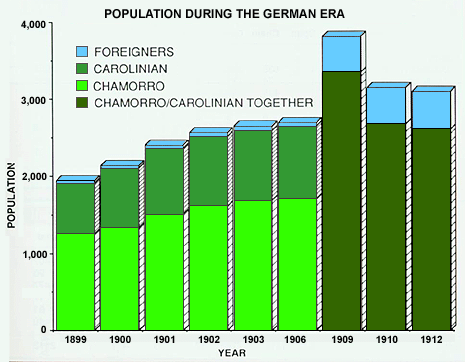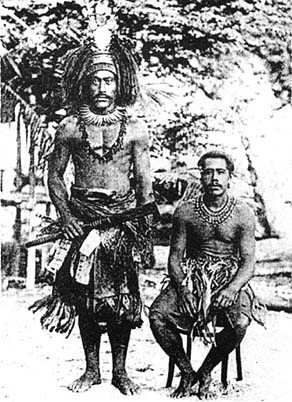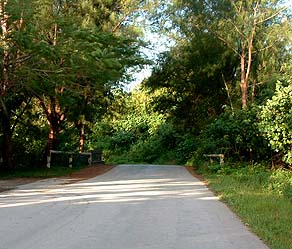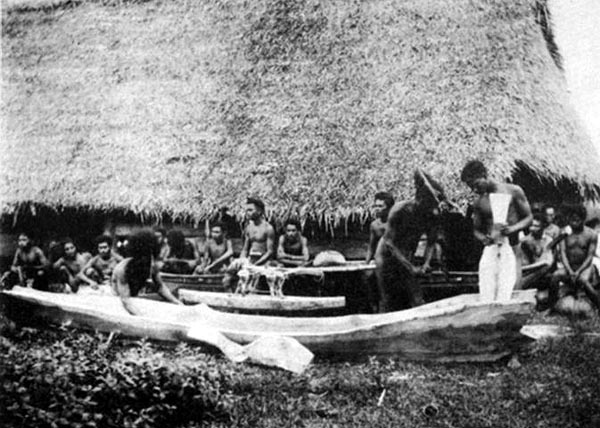 |
 |
 |
|||||
|
|
|
|
|
|
|
|
|
|
|
|||||||
“Tanapag was temporarily abandoned in the very early 20th century,” Scott tells us. “There was a storm that hit with big storm waves, and the village got wiped out. The houses were destroyed by the heavy storm surge, and the Germans thought that it was in a vulnerable area, so they encouraged the people to move to a new spot. The Germans called it Neuheim, ‘New Settlement’ or ‘New Village,’ and I think it was somewhere in the vicinity of where Puerto Rico is now. I don’t know if anybody remembers that because it didn’t last for very long. The people didn’t like the location and they basically defied the Germans and moved back there to Tanapag.”
|
||
|
|
||
|
“In 1909, the Germans exiled a group of eleven Samoan chiefs here, part of the Mau movement in Western Samoa, and they established their village just south of Tanapag. There used to be a trailer park there which is now gone, but I think people in Tanapag still remember that that’s where the Samoan village was. And that village was there until 1915 when the Japanese took over. Then they were repatriated back to Samoa.” “During those times, our land down here was where the Samoan people used to stay,” Rosa Castro recalls, “but I heard very little about it.” “I really don’t know how long the Samoans stayed because I was probably not born,” Ben adds, “but when I grew up, I heard of the Samoans. I didn’t see any Samoans. I just saw a kamachili tree—it’s a fruit tree—and cows. I don’t know what they did or where they were at the time.”
|
|
|
"The only two traditional villages that were here during the German era were Garapan and Tanapag," Scott continues, "So older people, most Chamorros in their 70s, and most Carolinians with the exception of the Tanapag people, they would have lived in Garapan. That would have been their place. "The Chamorros lived in the northern part, the Carolinians lived in the southern part and they started renting out their houses to the Japanese during the Japanese period. Some of them moved to their farms, which are still pretty much in that same general area. Those are what people considered the traditional villages." |
|
|
|
|
“The Japanese brought in tens of thousands of laborers, some Korean laborers but mostly Okinawans because they worked more cheaply than mainland Japanese and they were used to the warm climate. On Saipan there were 35,000 to 40,000 Japanese nationals just before World War II broke out. Garapan had 20,000-25,000 people living there. There was Chalan Kanoa, and other little rural areas with clusters of houses with agricultural workers were living there. It was a real boom time.” “Okinawans are the people who worked on the sugar cane,” Jesus points out. “Okinawans planted sugar cane and sold it to the factory and the company. We Chamorros, at the farm, we would plant sweet potato, casaba, or tapioca, dry land taro."
|
||
|
|
||
|
“During the Japanese time, the Carolinians would mingle with the Chamorros," Jesus reflects, "but more so after the war. That is a very big change, because in those days Carolinians would speak only Carolinian. Today, most Tanapag Carolinians speak Chamorro.” “There were three or four Japanese families here in the village,” Rosa Castro recalls. “There was one right next to us. His name was Toyoshima and he had a store; just down south of us was Asato, and very close over here by the church was Kondo. There were others around but not inside the village. Only these three were in the village, and they were store owners.” “The people in Tanapag are primarily Carolinians. However there are a few Chamorros that were here, families that are here in Tanapag. Vicente Magofna, Benancio Magofna, and Juan Babauta, the great-grandfather of the governor. And Tan Maria Sablan—we call her Tan Maria, which means Auntie Mary Sablan.”
|
|
|
“The community was mixed blooded,” Pete agrees, “but mostly there were a lot of Carolinians over here, more Carolinians in the village than Chamorro. The Sablan families, and the Magofna were the only Chamorros in Tanapag before. “During those years, families were living in one house. My grandfather, my grandmother, my mother, my uncles, they all stayed in only one house. Now it’s different. We all split up. During my time, we didn’t need to work for money. We all depended on farming and fishing. And that’s what we lived on. My parents were not working, just farming and fishing. I grew up with that. I worked on the farm. I went fishing. Both ways.” “The custom then, and I call it a beautiful custom,” Rosa smiles, “is that when somebody came here and was going to stay here and going to build a thatch house, the people here, primarily the Carolinians, did not have to be invited to come and help. They voluntarily came and helped build this house for the people who decided to move here.”
|
|
|
|
|
Among the Carolinian community in Tanapag, clan membership was an important distinction. "The most populous clan is the Remar clan," Ben explains. "Then there’s the Rewiite clan and the Refalamei clan." "Remar is the clan that has been the acting chief since the time when my grandmother was still alive," Pete says. "They’re chiefs, because Remar is higher than the Rewiite and the Refalamei. I remember my grandmother as being the highest during those times, and because she was a woman, she appointed one person within the clan to be the spokesman for the clan. She appointed Pepe Lifoifoi as spokesman for the Remar clan." The way that clan membership and position within the clan is inherited follows a matrilineal pattern. Ben and Pete explain:
|
||
|
|
||
"Clan membership is passed on both sides," Ben says, "but you tend to lose rank on the paternal side, called afaghúr. You gain rank on the maternal side, called ainang. This is most easily shown through the inter-marriage and assimilation of our two populations. "If a woman of Carolinian descent marries a Chamorro man, that child would have only the mother’s clan, and it would be called ainang. There’s no afaghúr, no man’s side, only the woman’s side. "My case is the opposite: my Carolinian father married my mother who is Chamorro, so I don’t have ainang, the clan from the mother’s side. I’m an afaghúr, with clanship from the father’s side. So normally, I won’t be a chief. I would be the right hand man of the chief."
|
|
|
"The chiefly position is
hereditary, but you have to be in the upper echelon. The chief’s
clanship would come from his ainang, or mother’s side.
The afaghúr (men’s side) does not produce a chief.
If my mother had been a Carolinian of high clanship, I would be eligible
for chief. I think my sister’s children, my niece and nephews,
may be eligible for a chiefly position, but none of the male gender
would produce one. It’s interesting in the clanship organization.
"When a high-ranking woman has children," Pete explains, "the first boy becomes a chief. Only the male can become a chief. But if that boy becomes a chief, and he has a son, then his boy will not become a chief. However, if this chief has a daughter, the daughter’s son then becomes a chief. Take myself for example: I am a chief, and I have a son. My son will not become a chief. But if my daughter has a boy, that boy will become a chief. So it always skips generations."
|
|
|
|
| "The Chief had the power in those days, to say, ‘No fishing on this area for this period of time.’ Or because you disobeyed or disrespected certain traditions, the chief would not allow you to fish on the traditional fishing grounds." We will learn about the current state of clanship in Tanapag later. Now we consider the aftermath of colonization for Saipan and CNMI.
|
||
|
|
||
|
|
|
|
|
|

|
| Tanapag Home | Map Library | Site Map | Pacific Worlds Home |
|
|
|
|

|
|
|
|||
| Copyright 2003 Pacific Worlds & Associates • Usage Policy • Webmaster |
|||












